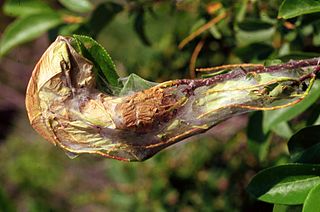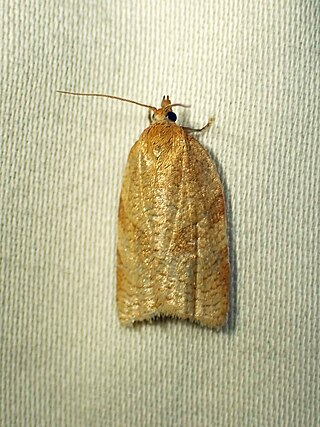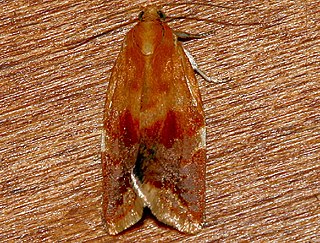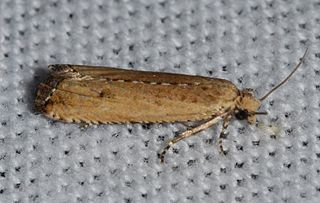
Lobesia botrana, the European grapevine moth or European grape worm, is a moth of the family Tortricidae.

Autographa sansoni, the Alberta beauty, is a moth of the family Noctuidae. The species was first described by F. H. Wolley Dod in 1910. It is found in the western mountains of North America, from Alaska south to Oregon, Idaho and Arizona. Occurring mainly in the Pacific Northwest, it thrives in mid-to-high elevation conifer forest habitat, as well as some areas of coastal rain forest in the Coast range. However, it is also found in a non-contiguous range in sub-alpine forest in the Rocky Mountains, ranging from Alberta in the north, to New Mexico in the south. The wingspan of an adult ranges between 34 and 36 mm. It is widespread, and a relatively common species.

Anopina is a genus of moths belonging to the subfamily Tortricinae of the family Tortricidae.

Platynota is a genus of moths belonging to the subfamily Tortricinae of the family Tortricidae.

Taniva is a monotypic moth genus belonging to the family Tortricidae erected by Carl Heinrich in 1926. Its only species, Taniva albolineana, the spruce needleminer moth, was first described by William D. Kearfott in 1907.

Cryptophlebia ombrodelta, the litchi fruit moth or macadamia nut borer, is a moth of the family Tortricidae. The species was first described by Oswald Bertram Lower in 1898. It is native to India, Sri Lanka, Nepal, Indonesia, China, Taiwan, Vietnam, Thailand, western Malaysia, New Guinea, the Philippines, Japan, Guam, the Caroline Islands, Australia and has been introduced to Hawaii.

Amblyptilia pica, the geranium plume moth, is a moth of the family Pterophoridae. The species was first described by Baron Walsingham in 1880. It is found in western North America from Alaska to California, inland to Alberta and Kansas. It is also found in the north-eastern United States and Ontario.

Archips cerasivorana, the ugly-nest caterpillar moth, is a species of moth of the family Tortricidae. The caterpillars of this species are known to create nests by tying the leaves of their host plant together. Within the nests, they live and feed off the leaves that have been tied together. The larvae are brownish or greenish yellow with a shiny dark brown head. Larvae can be found from May to July. The species overwinters as an egg, and pupation takes place within the nest. Caterpillars are seen to follow one another in trails, a behavior prompted by the release of signaling pheromones from their spinnerets.
Lampronia aenescens is a moth of the family Prodoxidae first described by Walsingham in 1888. In North America it is found in Alberta and ranges west and south through southern British Columbia to northern California and Colorado.

Choristoneura albaniana is a moth of the family Tortricidae. It was described by Francis Walker in 1863. In North America it is found from Alaska to Newfoundland, south through the mountains to California, Maine and New Hampshire. It is also found in the northern parts of the Palaearctic region, where it has been recorded from Sweden, Finland, Russia. The habitat consists of forests in boreal and mountainous regions.

Aphelia alleniana, the wide-striped leafroller, is a species of moth of the family Tortricidae. It is found in North America, where it has been recorded throughout Canada, as far north as Alaska. In the United States, it has been recorded from Colorado, Maine and Montana.
Archepandemis coniferana is a species of moth of the family Tortricidae first described by Akira Mutuura in 1978. It is found in North America, where it has been recorded from Alberta, British Columbia and California. The habitat consists of coniferous forests.
Archips alberta is a species of moth of the family Tortricidae first described by James Halliday McDunnough in 1923. It is found in North America, where it has been recorded across boreal Canada, south through the mountains to Utah. The habitat consists of coniferous forests.
Argyrotaenia occultana, the fall spruce needle moth, is a moth of the family Tortricidae. The species was first described by Thomas Nesbitt Freeman in 1942. It is found in North America, where it has been recorded from British Columbia north to Yukon and Northwest Territories, east to Newfoundland and south to Kentucky and Oregon. The habitat consists of spruce forests.

Eana argentana is a moth of the family Tortricidae. It is found in Great Britain, Spain, France, Luxembourg, Belgium, the Netherlands, Germany, Austria, Switzerland, Italy, the Czech Republic, Slovakia, Poland, Albania, Bosnia and Herzegovina, Slovenia, Hungary, Bulgaria, Romania, North Macedonia, Greece, Norway, Sweden, Finland, the Baltic region and Russia. It is also present in western North America, where it has been recorded from Alaska, Alberta, Arizona, British Columbia, California, Maine, Montana, New Mexico, Washington and Wyoming. The habitat consists of high-elevation open habitats.
Choristoneura zapulata, the zapulata moth, is a moth of the family Tortricidae. The species was first described by Robinson in 1869. It is found in North America, where it has been recorded from British Columbia to Quebec, south to California, Illinois and Pennsylvania.

Clepsis persicana, the white triangle tortrix or the green needleworm, is a species of moth of the family Tortricidae. It is found in North America, where it has been recorded from Alaska and British Columbia to Newfoundland and south to Virginia and west to California. The habitat consists of coniferous and mixed coniferous forests.

Clepsis virescana, the light brown apple moth, is a species of moth of the family Tortricidae. It is found in North America, where it is widespread in southern Canada and most of the United States. The habitat consists of shrubby open areas and aspen parkland.
Pandemis canadana, the green aspen leaftier, is a moth of the family Tortricidae. The species was first described by William D. Kearfott in 1905. It is found in North America, where it has been recorded from British Columbia to Nova Scotia, south to Colorado, Illinois and Maine. The habitat consists of deciduous forests and shrubs.

Bactra verutana, the javelin moth, is a species of moth of the family Tortricidae. It is found in North America, where it has been recorded from Florida, Texas, Mississippi, North Carolina, Indiana, Missouri, Ontario, Alberta, Quebec and Labrador. It is also found in Cuba, Mexico, Panama, Paraguay, Puerto Rico, Mozambique and South Africa. The habitat consists of prairies, aspen parkland, foothills and mixed wood areas.













